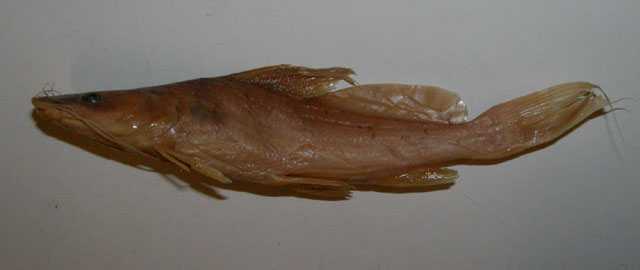|
Dorsal spines (total): 1-1; Dorsal soft rays (total): 10-11; Anal soft rays: 12-13. Diagnosis: body rather elongate, 6 times longer than deep; occipital process 3-5 times longer than broad (Ref. 57125). 10-11 branched dorsal-fin rays (Ref. 57125), 1st extended into long filament, following into shorter ones (Ref. 7324, 31256, 57125). Longest filament comprised 2 to 3 times in standard length (Ref. 3036, 57125). Predorsal length comprised 2.6 to 2.9 times in standard length; head width 1.6-1.9 times in head length; width of premaxillary tooth plate 2.4-2.8 times in head length; upper caudal-fin lobe often prolonged into a short filament (Ref. 7324, 57125). Upper caudal-fin lobe comprised 2.5 to 3.5 times in standard length (Ref. 57125).
Description: snout slightly rounded and protruded (Ref. 3055). Maxillary barbel 1.5-3.2 times head length (Ref. 3032), reaching the anal fin in juveniles and the pectoral fin in adults; nasal barbel 0.2 times head length (Ref. 3055). External mandibulary barbel 0.6-1 times head length (Ref. 3032), 1.5-2 times the length of the internal mandibulary barbel (Ref. 2756). Internal mandibulary barbel 0.42-0.56 times head length (Ref. 3069). Eyes supralateral (Ref. 2756). Occipital processus long, close to the interneural (Ref. 3055). Dorsal spine smooth (Ref. 3069). Only the first branched ray is filamentous in juveniles (Ref. 3069, Ref. 2756). Adipose fin height 4.1-5.7 times into length of its base (Ref. 3036), 1.75 times longer than the dorsal fin (Ref. 3056, Ref. 3055). Distance between dorsal and adipose fin small (Ref. 2756). Caudal fin deeply forked (Ref. 3056). Lower lobe of caudal fin rounded and without filament (Ref. 3056). Pectoral filaments often present (Ref. 13851, Ref. 3036, Ref. 3055), reaching the pelvics (Ref. 3069). Strong pectoral spine present (Ref. 3069, Ref. 3032). Pelvic fins more inserted under 7-8 branched rays of dorsal fin (Ref. 13851, Ref. 3036).
Coloration: life specimens greyish or yellowish, with a white belly (Ref. 7324, 57125). Fins grey, often tinged with rose (Ref. 7324, 13851, 57125). Caudal fin sometimes with black spots; juveniles are blackish (Ref. 7324, 57125). |

